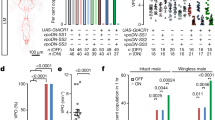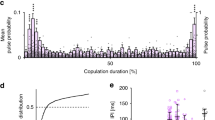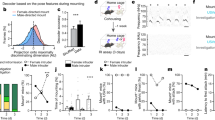Abstract
Various social behaviours in mice are regulated by chemical signals called pheromones that act through the vomeronasal system1,2,3. Exocrine gland-secreting peptide 1 (ESP1) is a 7-kDa peptide that is released into male tear fluids and stimulates vomeronasal sensory neurons in female mice4. Here, we describe the molecular and neural mechanisms that are involved in the decoding of ESP1 signals in the vomeronasal system, which leads to behavioural output in female mice. ESP1 is recognized by a specific vomeronasal receptor, V2Rp5, and the ligand–receptor interaction results in sex-specific signal transmission to the amygdaloid and hypothalamic nuclei via the accessory olfactory bulb. Consequently, ESP1 enhances female sexual receptive behaviour upon male mounting (lordosis), allowing successful copulation. In V2Rp5-deficient mice, ESP1 induces neither neural activation nor sexual behaviour. These findings show that ESP1 is a crucial male pheromone that regulates female reproductive behaviour through a specific receptor in the mouse vomeronasal system.
This is a preview of subscription content, access via your institution
Access options
Subscribe to this journal
Receive 51 print issues and online access
$199.00 per year
only $3.90 per issue
Buy this article
- Purchase on Springer Link
- Instant access to full article PDF
Prices may be subject to local taxes which are calculated during checkout




Similar content being viewed by others
Accession codes
Primary accessions
GenBank/EMBL/DDBJ
Data deposits
The sequences of V2Rp1–V2Rp7 are deposited in GenBank under accession numbers AB540943–AB540949.
References
Wyatt, T. D. Pheromones and Animal Behaviour (Cambridge Univ. Press., 2003)
Dulac, C. & Torello, A. T. Molecular detection of pheromone signals in mammals: from genes to behaviour. Nature Rev. Neurosci. 4, 551–562 (2003)
Touhara, K. Molecular biology of peptide pheromone production and reception in mice. Adv. Genet. 59, 147–171 (2007)
Kimoto, H., Haga, S., Sato, K. & Touhara, K. Sex-specific peptides from exocrine glands stimulate mouse vomeronasal sensory neurons. Nature 437, 898–901 (2005)
Touhara, K. & Vosshall, L. B. Sensing odorants and pheromones with chemosensory receptors. Annu. Rev. Physiol. 71, 307–332 (2009)
Haga, S., Kimoto, H. & Touhara, K. Molecular characterization of vomeronasal sensory neurons responding to a male-specific peptide in tear fluid: Sexual communication in mice. Pure Appl. Chem. 79, 775–784 (2007)
Kimoto, H. et al. Sex- and strain-specific expression and vomeronasal activity of mouse ESP family peptides. Curr. Biol. 17, 1879–1884 (2007)
He, J., Ma, L., Kim, S., Nakai, J. & Yu, C. R. Encoding gender and individual information in the mouse vomeronasal organ. Science 320, 535–538 (2008)
Leypold, B. G. et al. Altered sexual and social behaviors in trp2 mutant mice. Proc. Natl Acad. Sci. USA 99, 6376–6381 (2002)
Ishii, T., Hirota, J. & Mombaerts, P. Combinatorial coexpression of neural and immune multigene families in mouse vomeronasal sensory neurons. Curr. Biol. 13, 394–400 (2003)
Loconto, J. et al. Functional expression of murine V2R pheromone receptors involves selective association with the M10 and M1 families of MHC class Ib molecules. Cell 112, 607–618 (2003)
Del Punta, K., Puche, A., Adams, N. C., Rodriguez, I. & Mombaerts, P. A divergent pattern of sensory axonal projections is rendered convergent by second-order neurons in the accessory olfactory bulb. Neuron 35, 1057–1066 (2002)
Ishii, T. & Mombaerts, P. Expression of nonclassical class I major histocompatibility genes defines a tripartite organization of the mouse vomeronasal system. J. Neurosci. 28, 2332–2341 (2008)
von Campenhausen, H. & Mori, K. Convergence of segregated pheromonal pathways from the accessory olfactory bulb to the cortex in the mouse. Eur. J. Neurosci. 12, 33–46 (2000)
Meredith, M. Vomeronasal, olfactory, hormonal convergence in the brain. Cooperation or coincidence? Ann. NY Acad. Sci. 855, 349–361 (1998)
Yoon, H., Enquist, L. W. & Dulac, C. Olfactory inputs to hypothalamic neurons controlling reproduction and fertility. Cell 123, 669–682 (2005)
Simerly, R. B. & Swanson, L. W. The organization of neural inputs to the medial preoptic nucleus of the rat. J. Comp. Neurol. 246, 312–342 (1986)
Canteras, N. S., Simerly, R. B. & Swanson, L. W. Organization of projections from the medial nucleus of the amygdala: a PHAL study in the rat. J. Comp. Neurol. 360, 213–245 (1995)
Pfaff, D. W. & Sakuma, Y. Facilitation of the lordosis reflex of female rats from the ventromedial nucleus of the hypothalamus. J. Physiol. (Lond.) 288, 189–202 (1979)
Blaustein, J. D. & Erskine, M. S. in Hormones, Brain and Behavior (eds Pfaff, D. W. et al.) 139–214 (Academic, 2002)
Halem, H. A., Cherry, J. A. & Baum, M. J. Vomeronasal neuroepithelium and forebrain Fos responses to male pheromones in male and female mice. J. Neurobiol. 39, 249–263 (1999)
Pierman, S., Douhard, Q. & Bakker, J. Evidence for a role of early oestrogens in the central processing of sexually relevant olfactory cues in female mice. Eur. J. Neurosci. 27, 423–431 (2008)
Wu, M. V. et al. Estrogen masculinizes neural pathways and sex-specific behaviors. Cell 139, 61–72 (2009)
Boschat, C. et al. Pheromone detection mediated by a V1r vomeronasal receptor. Nature Neurosci. 5, 1261–1262 (2002)
Mombaerts, P. Genes and ligands for odorant, vomeronasal and taste receptors. Nature Rev. Neurosci. 5, 263–278 (2004)
Nakagawa, T., Sakurai, T., Nishioka, T. & Touhara, K. Insect sex-pheromone signals mediated by specific combinations of olfactory receptors. Science 307, 1638–1642 (2005)
Datta, S. R. et al. The Drosophila pheromone cVA activates a sexually dimorphic neural circuit. Nature 452, 473–477 (2008)
Semmelhack, J. L. & Wang, J. W. Select Drosophila glomeruli mediate innate olfactory attraction and aversion. Nature 459, 218–223 (2009)
Zijlstra, M. et al. Beta 2-microglobulin deficient mice lack CD4–8+ cytolytic T cells. Nature 344, 742–746 (1990)
Lalioti, M. & Heath, J. A new method for generating point mutations in bacterial artificial chromosomes by homologous recombination in Escherichia coli. Nucleic Acids Res. 29, E14 (2001)
Skene, J. H. & Virag, I. Posttranslational membrane attachment and dynamic fatty acylation of a neuronal growth cone protein, GAP-43. J. Cell Biol. 108, 613–624 (1989)
Nagai, T. et al. A variant of yellow fluorescent protein with fast and efficient maturation for cell-biological applications. Nature Biotechnol. 20, 87–90 (2002)
Bunting, M., Bernstein, K. E., Greer, J. M., Capecchi, M. R. & Thomas, K. R. Targeting genes for self-excision in the germ line. Genes Dev. 13, 1524–1528 (1999)
Taniguchi, M. et al. Disruption of semaphorin III/D gene causes severe abnormality in peripheral nerve projection. Neuron 19, 519–530 (1997)
Kudwa, A. E., Bodo, C., Gustafsson, J. A. & Rissman, E. F. A previously uncharacterized role for estrogen receptor beta: defeminization of male brain and behavior. Proc. Natl Acad. Sci. USA 102, 4608–4612 (2005)
Acknowledgements
We thank R. Axel, C. R. Yu, M. Cappechi, M. Sugita and T. Shiroishi for mice and plasmids; RIKEN BSI Research Resource Center, Y. Zhang, J. He, C. R. Yu, H. Kimoto, N. Matsumoto, M. Ohmoto, K. Abe, S. Mitsui, T. Kaneko-Goto, and T. Abe for experimental help and advice; and Y. Sakuma, Y. Mori, M. Ichikawa and H. Terasawa for valuable comments and discussions. This work was supported by grants from the Program for Promotion of Basic Research Activities for Innovative Biosciences, Japan Society for the Promotion of Science, and Ministry of Education, Culture, Sports, Science and Technology, Japan.
Author information
Authors and Affiliations
Contributions
Experiments were performed by S.H. (Figs 1, 2, 3, 4 and Supplementary Figs 1–14), S.H. and K.S. (Fig. 1e–h) and T.K., T.H. and S.H. (Fig. 4a–d and Supplementary Figs 11–14). S.H. and Y.Y. generated the BAC transgenic mice. T.S. and Y.Y. generated the V2Rp5-deficient mice. R.K. and H.S. advised on the construction of the BAC transgene. K.T. supervised the project. The manuscript was written by S.H., Y.Y. and K.T.
Corresponding author
Ethics declarations
Competing interests
The authors declare no competing financial interests.
Supplementary information
Supplementary Figures
This file contains Supplementary Figures S1-S14 with legends. (PDF 4238 kb)
Supplementary Movie 1
This file contains the control movie. (MOV 5630 kb)
Supplementary Movie 2
This file contains the ESP1 movie. (MOV 7555 kb)
Rights and permissions
About this article
Cite this article
Haga, S., Hattori, T., Sato, T. et al. The male mouse pheromone ESP1 enhances female sexual receptive behaviour through a specific vomeronasal receptor. Nature 466, 118–122 (2010). https://doi.org/10.1038/nature09142
Received:
Accepted:
Issue Date:
DOI: https://doi.org/10.1038/nature09142
This article is cited by
-
Chemical communication and its role in sexual selection across Animalia
Communications Biology (2023)
-
Reproductives signature revealed by protein profiling and behavioral bioassays in termite
Scientific Reports (2023)
-
Oleoylethanolamide restores stress-induced prepulse inhibition deficits and modulates inflammatory signaling in a sex-dependent manner
Psychopharmacology (2023)
-
Hemoglobin in the blood acts as a chemosensory signal via the mouse vomeronasal system
Nature Communications (2022)
-
Remarkable diversity of vomeronasal type 2 receptor (OlfC) genes of basal ray-finned fish and its evolutionary trajectory in jawed vertebrates
Scientific Reports (2022)
Comments
By submitting a comment you agree to abide by our Terms and Community Guidelines. If you find something abusive or that does not comply with our terms or guidelines please flag it as inappropriate.



